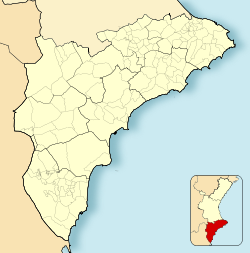Villena | |
|---|---|
City | |
Aerial view of Villena Archpriestal St. James Church Chapí Theatre at Paseo Chapí Municipal Palace (City Hall) Moors and Christians Festival | |
| Motto: Villena ¡un tesoro! | |
| Coordinates: 38°38′6″N 0°51′57″W / 38.63500°N 0.86583°W | |
| Country | |
| Autonomous Community | |
| Province | Alicante |
| Comarca | Alto Vinalopó |
| Populated places | |
| Government | |
| • Mayor | Francisco Javier Esquembre Menor (LVE) |
| Area | |
| • Total | 345.6 km2 (133.4 sq mi) |
| Elevation | 505 m (1,657 ft) |
| Population (2018)[2] | |
| • Total | 33,983 |
| • Density | 98/km2 (250/sq mi) |
| Time zone | UTC+1 (CET) |
| • Summer (DST) | UTC+2 (CEST) |
| Postal code | 03400 |
| Website | Official website (in Spanish) |
Villena (Spanish: [biˈʎena]; Valencian pronunciation: [viˈʎena]) is a city in Spain, in the Valencian Community. It is located at the northwest part of Alicante, and borders to the west with Castilla-La Mancha and Murcia, to the north with the province of Valencia and to the east and south with the province of Alicante. It is the capital of the comarca of the Alto Vinalopó. The municipality has an area of 345.6 km² and a population of 34,144 inhabitants as of INE 2023.[3]
There is evidence of settlement in the area from Middle Paleolithic.[4] However, it is on dispute if the current city dates from visigothic times or before, though certainly it existed in the 11th century, during the Muslim period.[5] After the Christian conquest,[6] it became Seigneury, Principality, Duchy and finally Marquisate,[7] until the people, encouraged by the Catholic Monarchs, revolted against the marquis. In 1525 Charles V conceded the title of City to Villena.[8] This is the most economically prosperous period, as shown by the monuments that survived to nowadays. Although a railway station was inaugurated in 1858,[9] economy kept being mainly agricultural until the rural exode that took place in the 1960s. Then, the economic model changed rapidly so that currently economy is based mainly on tertiary sector and industry, chiefly footwear, construction and furniture.[10]
The historical city and surroundings contain an important group of historical remains,[11] including two castles and several churches, hermitages, palaces and squares, as well as a number of museums, standing out the Archaeological Museum "José María Soler". Among the main cultural events are the Moors and Christians festival and the Concurso de Jóvenes Intérpretes "Ruperto Chapí" (Young Interpreters Contest).
- ^ "Nomenclátor. Relación de unidades poblacionales. Villena". ine.es. Retrieved 21 February 2010.
- ^ Municipal Register of Spain 2018. National Statistics Institute.
- ^ "Series de población de los municipios de España desde 1996". Instituto Nacional de Estadística (Spain).
- ^ SOLER GARCÍA, José María (2006). Historia de Villena: desde la Prehistoria hasta el siglo XVIII [History of Villena: from Prehistory to the 18th Century] (pdf) (in Spanish). Digitalised by the Biblioteca Virtual Miguel de Cervantes (1st ed.). Villena: Fundación Municipal José María Soler & M.I. Ayuntamiento de Villena. p. 5. ISBN 978-84-934950-0-8. Retrieved August 12, 2009.
- ^ SOLER GARCÍA, José María (2006). Historia de Villena: desde la Prehistoria hasta el siglo XVIII [History of Villena: from Prehistory to the 18th Century] (pdf) (in Spanish). Digitalised by the Biblioteca Virtual Miguel de Cervantes (1st ed.). Villena: Fundación Municipal José María Soler & M.I. Ayuntamiento de Villena. p. 42. ISBN 978-84-934950-0-8. Retrieved August 12, 2009.
- ^ GARRIDO, David (2008). "Reivindicación del Medioevo villenense" [Claim of Villena's Middle Ages]. Moros y Cristianos · Villena [Moors & Christians · Villena] (in Spanish). Villena: Ayuntamiento de Villena.
- ^ SOLER GARCÍA, José María (2006). Historia de Villena: desde la Prehistoria hasta el siglo XVIII [History of Villena: from Prehistory to the 18th Century] (pdf) (in Spanish). Digitalised by the Biblioteca Virtual Miguel de Cervantes (1st ed.). Villena: Fundación Municipal José María Soler & M.I. Ayuntamiento de Villena. p. 109. ISBN 978-84-934950-0-8. Retrieved August 12, 2009.
- ^ SOLER GARCÍA, José María (2006). Historia de Villena: desde la Prehistoria hasta el siglo XVIII [History of Villena: from Prehistory to the 18th Century] (pdf) (in Spanish). Digitalised by the Biblioteca Virtual Miguel de Cervantes (1st ed.). Villena: Fundación Municipal José María Soler & M.I. Ayuntamiento de Villena. p. 229. ISBN 978-84-934950-0-8. Retrieved August 12, 2009.
- ^ "La construcción de la red ferroviaria alicantina: Proceso de construcción" [Building of the railway network in Alicante: Building process]. 150 años del ferrocarril de Alicante [150 years of railway in Alicante] (in Spanish). Retrieved August 12, 2009.
- ^ Pateco. Cámaras de Comercio de la Comunidad Valenciana (Pateco. Commerce Chambers of the Valencian Community) (2002). "Análisis socioeconómico" [Socio-Economic Analysis] (PDF). Plan de Acción Comercial de Villena [Commercial Action Plan for Villena] (in Spanish).
- ^ Generalitat Valenciana. Conselleria de Cultura i Esport. Direcció General de Patrimoni Cultural Valencià [Valencian Government. Culture and Sport Council. General Direction of Valencian Cultural Heritage. "Casco antiguo" [Ancient City] (PDF) (in Spanish). Retrieved August 12, 2009.










